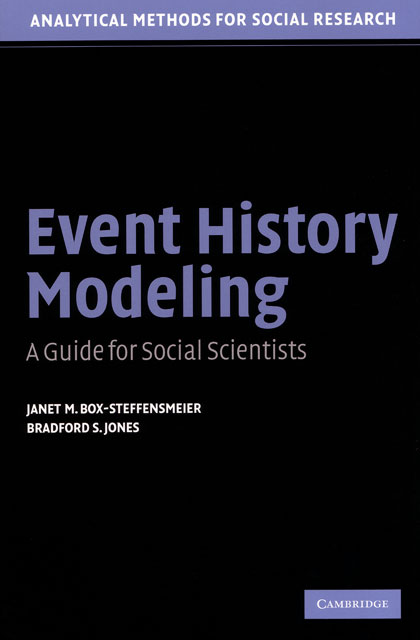

Stata 19 is here—explore all the features.
Event History Modeling: A Guide for Social Scientists |
||||||||||||||||||||||||||||||||||||
 Click to enlarge See the back cover |

As an Amazon Associate, StataCorp earns a small referral credit from
qualifying purchases made from affiliate links on our site.
eBook not available for this title
eBook not available for this title |
|
||||||||||||||||||||||||||||||||||
Comment from the Stata technical groupThis book provides an excellent introduction to the field of survival (duration) analysis for the social scientist. The mathematics are kept to a bare minimum, with more emphasis on the substantive issues behind the methods being demonstrated. Indeed, the authors are adept at explaining even the most complex mathematical and technical concepts through well-worded, descriptive text. Examples from the social sciences (e.g., a duration analysis of U.N. peacekeeping missions) are distributed throughout the text. This text also provides an excellent survey of the current state of the art in survival analysis, regardless of the field of application. Beginning with the basics—hazards and survival functions, parametric models, etc.—the discussion then extends toward advanced topics, such as models for correlated data (frailty models) and models for multiple events, e.g., competing risks. We highly recommend this book to researchers who are exploring advanced topics in survival analysis for the first time, as this text does a good job of mapping out the available methods and distinguishing between alternative new methods for analyzing the same types of data. The bibliography is also quite thorough. |
||||||||||||||||||||||||||||||||||||
Table of contentsView table of contents >> Preface
1. Event History and Social Science
2. The Logic of Event History Analysis
3. Parametric Models for Single-Spell Duration
4. The Cox Proportional Hazards Model
5. Models for Discrete Data
6. Issues in Model Selection
7. Inclusion of Time-Varying Covariates
8. Diagnostic Methods for the Event History Model
9. Some Modeling Strategies for Unobserved Heterogeneity
10. Models for Multiple Events
11. The Social Sciences and Event History
Appendix: Software for Event History Analysis
References
Index
|
||||||||||||||||||||||||||||||||||||
Learn
Free webinars
NetCourses
Classroom and web training
Organizational training
Video tutorials
Third-party courses
Web resources
Teaching with Stata
© Copyright 1996–2025 StataCorp LLC. All rights reserved.
×
We use cookies to ensure that we give you the best experience on our website—to enhance site navigation, to analyze usage, and to assist in our marketing efforts. By continuing to use our site, you consent to the storing of cookies on your device and agree to delivery of content, including web fonts and JavaScript, from third party web services.
Cookie Settings
Last updated: 16 November 2022
StataCorp LLC (StataCorp) strives to provide our users with exceptional products and services. To do so, we must collect personal information from you. This information is necessary to conduct business with our existing and potential customers. We collect and use this information only where we may legally do so. This policy explains what personal information we collect, how we use it, and what rights you have to that information.
These cookies are essential for our website to function and do not store any personally identifiable information. These cookies cannot be disabled.
This website uses cookies to provide you with a better user experience. A cookie is a small piece of data our website stores on a site visitor's hard drive and accesses each time you visit so we can improve your access to our site, better understand how you use our site, and serve you content that may be of interest to you. For instance, we store a cookie when you log in to our shopping cart so that we can maintain your shopping cart should you not complete checkout. These cookies do not directly store your personal information, but they do support the ability to uniquely identify your internet browser and device.
Please note: Clearing your browser cookies at any time will undo preferences saved here. The option selected here will apply only to the device you are currently using.